Understanding Karat: Insights into Gold Purity
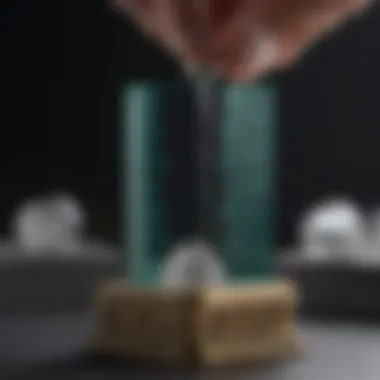
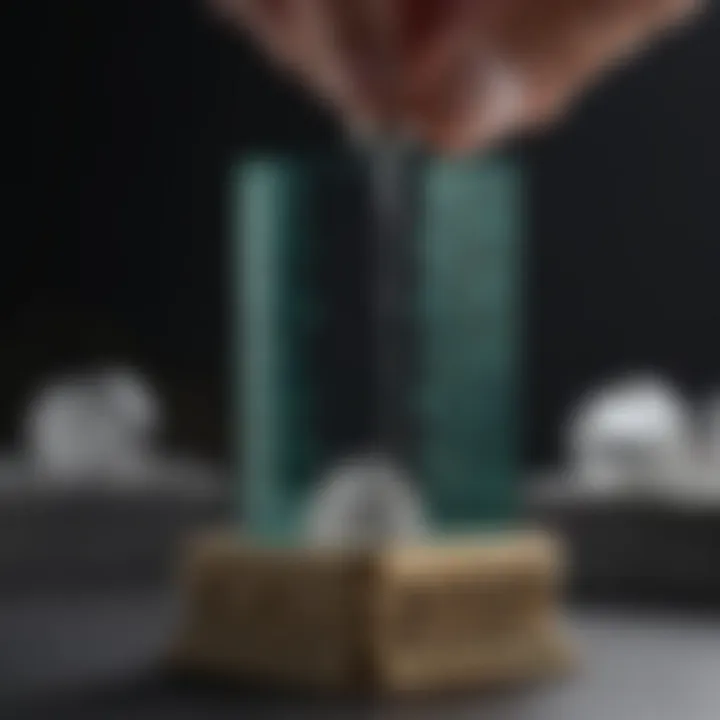
Intro
The world of gemstones is as vast and intricate as the cosmos itself, filled with nuances that challenge even the most astute enthusiast. At the heart of this dazzling realm is the concept of karat, a measure that holds import not just for jewelers but also for collectors and consumers alike. Understanding karat is essential for anyone interested in the quality, purity, and value of gemstones, particularly gold.
In this article, we take a comprehensive journey through the layers of karat, uncovering what it means in the context of both precious metals and gemstones. We'll delve into how karat serves as a benchmark for assessing gold purity and how it comes into play when evaluating gemstones. By grasping the intricacies of karat, enthusiasts and professionals will be empowered to make informed decisions that resonate well beyond the confines of a jewelry store.
Let’s embark on this exploration to illuminate the significance of karat and its impact on both the gemstones themselves and the marketplace.
Gemstone Overview
Gemstones, with their myriad colors, cuts, and characteristics, have captivated humanity for millennia. But before diving into the specifics of karat, it's vital to lay a foundation of understanding regarding gemstones themselves.
Definition and Characteristics
A gemstone is typically defined as a precious or semi-precious stone that has been cut and polished for use in jewelry. However, their value extends far beyond aesthetics. Gemstones are categorized based on factors such as
- Color
- Clarity
- Cut
- Carat weight
- Origin
Each of these characteristics contributes significantly to a gemstone's overall appeal. In a sense, one can think of these stones as nature's artwork, each telling its own story through the various hues and imperfections it carries.
Classification of Gemstones
Gemstones can be broadly categorized into two sections: precious and semi-precious. While the distinction has somewhat diminished in context over the years, it remains noteworthy. Precious gemstones typically include diamonds, rubies, sapphires, and emeralds. In contrast, semi-precious gemstones encompass a wider range, such as amethyst, garnet, aquamarine, and jade. Each class carries different market values and cultural significances, thereby affecting buyer perception and demand.
Historical Significance
Exploring the history of gemstones brings us into a rich tapestry interwoven with culture, mythology, and art. Throughout the ages, gemstones have been cherished not just for their beauty, but for the stories they tell and the powers they were believed to hold.
Ancient Uses and Cultural Importance
In ancient civilizations, gemstones were thought to possess healing properties or to provide protection. Egyptians were known to bury their dead with gemstones, believing these stones would offer guidance in the afterlife. Similarly, cultures around the world developed an array of symbolism—like how sapphires were associated with royalty and divine favor.
Myths and Legends Surrounding Gemstones
From Biblical texts that mention lapis lazuli to folklore featuring enchanted amulets, gemstones have been woven into the narratives of human existence for centuries. Much like fine wine, their stories aged over time, leading to contemporary notions of luck, love, and prosperity associated with wearing them. This aspect is not merely fanciful; it's embedded deeply into how gemstones, and by extension, karat is perceived today.
"Gemstones are the hard truths wrapped in tales of wonder and deprivation, reflecting humanity's quest for meaning and value."
As we transition into discussing karat more thoroughly, it's important to appreciate the historical context as it directly influences the valuation of gemstones in today’s market. By understanding this background, one equips themselves to navigate through the complexities of karats, the measures, and the values they embody.
What is Karat?
When diving into the world of gemstones and precious metals, understanding karat becomes paramount. This term doesn't just pop up randomly; it carries significant weight, especially when assessing the quality and value associated with gold and gems. In this section, we explore what karat actually means, its historical roots, and why it's a crucial concept for enthusiasts, collectors, and jewelry designers alike.
Definition of Karat
At its core, karat (or carat, in the context of gemstones) refers to the purity of gold or the weight of precious stones. When discussing gold's purity, karat is a measurement indicating the percentage of gold in an alloy. Pure gold is defined as 24 karats, which essentially means that the gold comprises 99.9% gold content. So when you come across other karat values, you might find the following breakdown:
- 18 karat gold: 75% gold and 25% other metals.
- 14 karat gold: 58.3% gold.
- 10 karat gold: 41.7% gold.
Using these definitions, one can gauge not only the purity of the gold but also its durability and suitability for various applications. Higher karat values suggest greater gold content but often result in softer metal, which may not withstand everyday wear as well as lower karat options.
Historical Background
The term "karat" has a rich historical lineage that ties back hundreds, if not thousands, of years. In ancient times, jewelers used various methods to measure gold's purity. The term karat actually originates from the carob seeds, which were once used as a means of weighing precious metals. These seeds were fairly uniform in size, making them an ideal choice in a time before precise scales were commonly available.
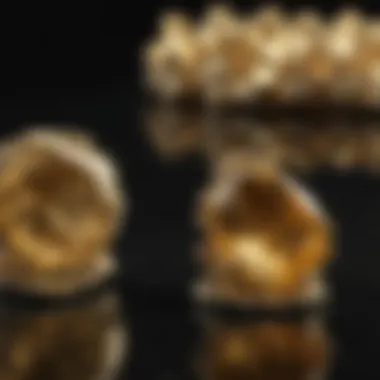
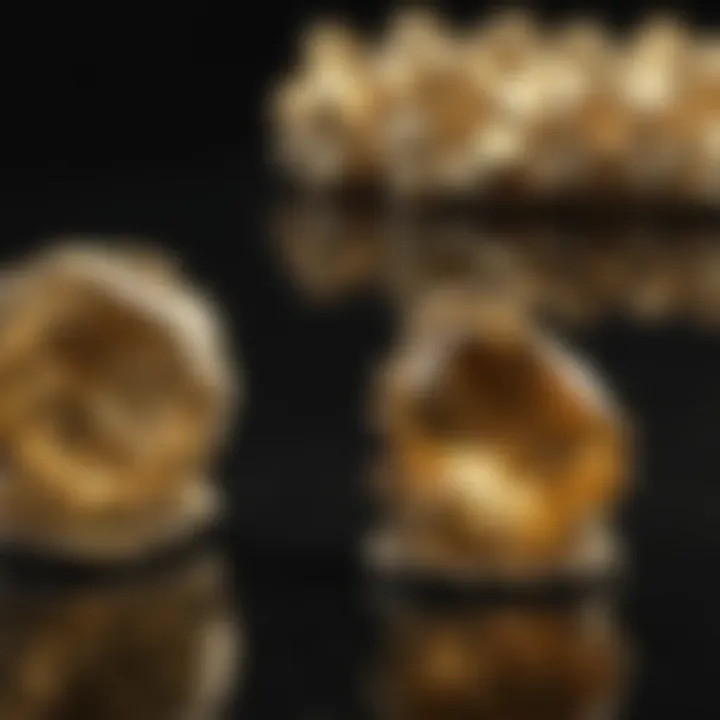
As trade began to flourish, particularly in the Mediterranean region, the adoption of the karat as a standard measurement spread widely. By the Middle Ages, the practice of setting a defined standard for karat purity became common in Europe. The Italian and German systems, which developed during this time, laid the groundwork for contemporary measurements.
Despite its long history, the concept of karat continues to evolve. Different countries and cultures have adopted their own standards and practices, contributing to the sometimes confusing landscape of gold purity measurement in today’s market.
"Understanding the historical context of karat not only enlightens collectors about their pieces but also adds a layer of appreciation for the artistry involved in their creation."
Through this exploration of karat's definition and historical backstory, it becomes clear how deeply intertwined this measurement is with the art of jewelry making and the market value of gold. As we move forward, a clearer grasp of these factors will aid enthusiasts and professionals alike in making informed decisions about their investments and creations.
The Science Behind Karat
Understanding karat involves more than merely knowing its numerical value. It delves into the chemistry of metals and the purity of gold used, which significantly impacts its overall quality and appeal. This section explains why the science of karat matters for enthusiasts and collectors alike. Knowing the karat helps in making informed choices, particularly when it comes to investments and valuations in jewelry and gemstones.
Karat as a Measurement of Purity
Karat is fundamentally a measure of the purity of gold and other precious metals. It can be somewhat confusing at first glance, as the term isn’t used universally across all measures of metals. Here’s a simple breakdown:
- 24 karat gold is regarded as pure, containing 99.9% gold.
- 18 karat gold boasts 75% gold content, making it a fine balance between luxury and durability.
- 14 karat gold contains 58.3% gold, offering a combination of value and resilience.
To possess a clearer view of purity, it’s vital to note that the karat signifies the ratio of alloy to gold. This understanding helps evaluate how homespun or mass-produced jewels can be in terms of quality. High karat levels contribute to greater value and are often favored for their luster.
The Standard Scale of Karat Measurements
The scale of karat measurements – a few levels, gives a comprehensive look at how gold is classified. Here are some specifics accompanying each standard:
Karat: Pure Gold
24 karat gold is the gold standard — if one is seeking pure gold, this is it. With 99.9% purity, it shimmer and shines like nothing else. However, it brings with it a couple of drawbacks. The soft metal is prone to scratching and bending, making it less favorable for everyday jewelry. Thus, while it’s excellent for investment or decorative purposes, those looking for durability might reconsider its practicality.
Karat: Common Standard
18 karat gold strikes a balance many find appealing. Composed of 75% gold, it offers a compromise between purity and robustness. This karat level is popular among jewelry artisans, as it combines aesthetic allure with physical strength, making it a favored choice for wedding bands and other jewelry subjected to daily wear. You get to enjoy the richness of gold without compromising your piece's longevity.
Karat: Popular Choice
14 karat gold is widely preferred in jewel-making. At 58.3% gold content, it provides a more affordable option without sacrificing style. This option is especially appealing for those on a tighter budget yet seeking quality. 14 karat jewelry can be easily maintained and is less susceptible to wear and tear. However, some purists may find the lower gold content less desirable, depending on their personal standards and preferences.
In the world of jewelry making and design, understanding these karat levels aids buyers in forming opinions grounded in factual basis, enhancing their purchasing decision.
Karat in the Context of Gemstones
Karat serves as a crucial marker in the realm of gemstones, fundamentally tied to quality and value. For jewelry designers and collectors alike, understanding karat transcends mere numbers; it encapsulates the integrity of the gemstone and extends to the artistry involved in crafting exquisite pieces. Recognizing its implications can lead to more informed decisions, ensuring that the investment aligns with personal taste and market realities.
Importance of Karat in Gemstone Quality
When deciding on gemstones, the concept of karat is pivotal. It’s not just a measure of weight or purity; it influences the gemstone's overall quality and appearance. For instance, a 1-carat diamond may appear different based on how well it has been cut or polished, yet the focus on karat helps assure buyers of its substance. Thus, consumers should consider how karat not only reflects the stone’s weight but also potential flaws or attributes inherent to that size.
Furthermore, higher karats often suggest a rarity that correlates with price. Whether a gemstone is a sapphire, emerald, or ruby, its karat value can considerably affect its market position. Buyers in the gemstone market may find that increasing the karat of a gemstone can lead to exponential jumps in price, justifying why it's essential to align karat values with intended use and aesthetic goals.
Common Misunderstandings Related to Karat
Despite its importance, misconceptions surrounding karat are prevalent among consumers and sometimes even collectors. A common myth is that a higher karat always equates to better quality. Thus, it can lead to confusion, especially for those new to gemstones. For instance, while a 24-karat gold ring may seem desirable, it is less suitable for regular wear due to its softness compared to 18 karat gold, which balances durability and aesthetics.
Another frequent misunderstanding is regarding karat as synonymous with carat, particularly in the gemstone sphere. While karat measures gold and platinum purity, carat focuses on the weight of gemstones. This mix-up can be costly for buyers misjudging their purchases based on the terminology. Additionally, karat values can vary among various cultures and geographic regions, which can also exacerbate misunderstandings.
Overall, grasping these intricacies about karat helps clear the fog, enabling enthusiasts and collectors to appreciate and value their gems accurately. As the market evolves, so does the collective understanding of how karat impacts not just the charm of gemstones, but also the decision-making process behind acquiring them.
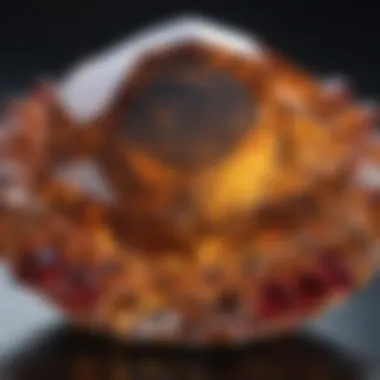
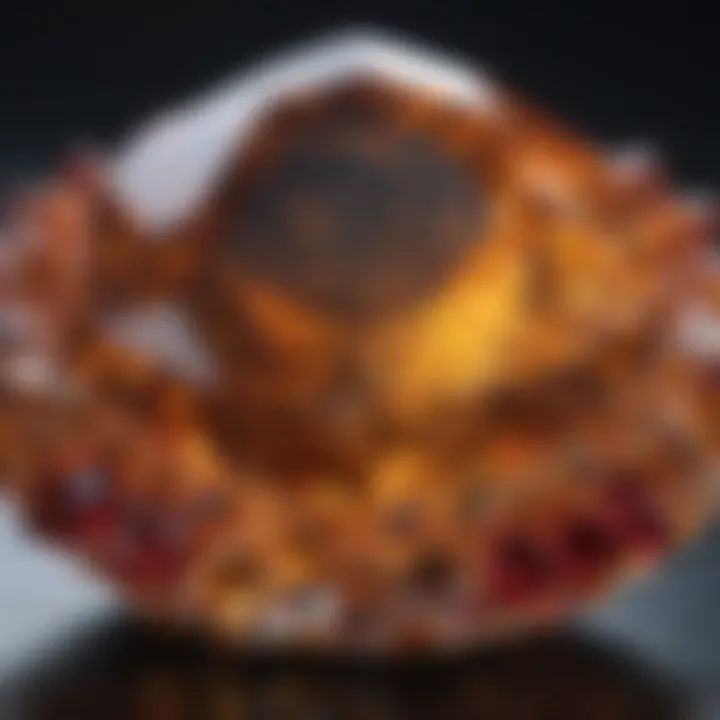
Karat Compared to Other Measurement Systems
When discussing the world of gemstones and precious metals, clarity is key. Understanding the concept of karat in comparison to other measurement systems becomes crucial for aficionados, collectors, and designers alike. It not only influences the perceived value but also allows individuals to make informed decisions in a marketplace that is often rife with confusion.
Karat vs. Carat: Understanding the Difference
At first glance, one might confuse karat with carat, but they are worlds apart. Karat refers to the purity of gold, while carat is a measure of weight for gemstones. The mix-up is understandable, since both terms are often used in the context of fine jewelry, but they serve different purposes.
- Karat: Primarily concerns itself with gold jewelry. The scale operates on a 24-point scale, where 24 karats denote pure gold. A ring that is 18 karats indicates that it comprises 75% gold and 25% other metals. This mix, known as alloy, can include metals such as copper or silver to strengthen the gold for practical use. The higher the karat, the greater the gold content, thereby influencing its value.
- Carat: Focuses on the weight of gemstones. One carat is equal to 200 milligrams. Gemstone weight directly affects value; however, factors like cut, clarity, and color significantly contribute to the final valuation as well. For instance, a one-carat diamond might show variance in value depending on these additional qualities.
In summary, while both terms are integral to the jewelry industry, karat zeroes in on gold purity and carat on gemstone weight. Knowing the difference helps enthusiasts navigate the complex landscape of jewelry valuation.
International Standards and Variations
Understanding karat also involves recognizing that different countries may have varying standards when it comes to gold purity measurement.
Several factors shape these variations:
- Cultural Practices: Some regions have specific traditions that dictate what karat constitutes acceptable gold quality. For example, in the United States, 14k is commonly favored, whereas countries like Italy and many Middle Eastern nations prefer 18k or higher.
- Legal Standards: Some countries enforce regulations that govern the minimum karat levels for selling gold as ‘fine’. Failure to comply could result in penalties or a tarnished reputation for jewelers.
- Marketplace Demand: Typically, markets adaptive to consumer preferences often dictate which karats are produced more frequently. An increasing interest in sustainable practices has led some jewelers to source and promote higher karat offerings, reflecting a commitment to quality.
Adapting to these variations is critical for anyone involved in the gemstone world. Paying attention to the standards applicable to your region can provide insights into what to expect when it comes to buying or selling gold jewelry.
"In the jargon of gold and gemstones, the vocabulary might seem daunting at first, but understanding key terms like karat and carat opens doors to informed purchases and investments."
By grasping these distinctions, consumers can confidently appreciate the nuances that govern their specific karat choices and navigate the marketplace with clarity. The importance of understanding how karat compares to other measurement systems cannot be understated – it empowers individuals with knowledge and, ultimately, sound decision-making.
Practical Implications of Karat in the Market
Karat plays a crucial role in the market for both gemstones and precious metals. It serves as a benchmark for quality and purity, influencing purchasing decisions and investment strategies alike. Understanding karat values is not just an academic exercise; it has real-world implications that can affect the lives of both consumers and investors.
Karat’s Role in Valuation
When it comes to valuation, karat is the cornerstone. For instance, a 24-karat gold piece is pure gold, whereas an 18-karat piece contains 75% gold and 25% other metals. This differentiation creates a spectrum of values in the market. As a seller, knowing the karat can significantly influence the pricing strategy. If a gold necklace is described as 14-karat, the buyer can instantly gauge its value based on the purity.
- Market Trust: Buyers tend to gravitate towards sellers who provide clear labeling of karat. Trust is key in any market. If a seller is transparent about the karat, it builds credibility.
- Price Fluctuations: Gold prices fluctuate, and knowing the karat helps in adjusting the price accordingly. For example, if the market dips, a seller accustomed to valuating based on purity may find their gold worth less, thus impacting supply and demand.
- Investment: Many people view gold as a safe investment. Understanding karat helps investors know what they’re purchasing. It’s one thing to have gold; it’s another to know its quality.
Just consider someone looking to invest in gold coins. If they don’t know that the investment they are making is only 10-karat, they might believe they are buying something of much higher value.
Factors Influencing Market Demand
Market demand for karat-rated items is influenced by various factors ranging from economic conditions to consumer behavior. Some of the key considerations include:
- Consumer Trends: These days, consumers are more informed than they used to be. Online platforms like Reddit and Facebook have made it easier for individuals to share information about karat and gemstones. The more they learn, the more discerning they become, which can push demand for higher karat options.
- Cultural Preferences: Different cultures have varying perceptions of what karat denotes. For instance, in some regions, 18-karat gold is more desirable than 24-karat due to its durability and appearance. Understanding these cultural nuances can greatly impact marketing strategies.
- Economic Factors: The economic climate can drive demand. During tough economic times, people might prefer to invest in lower karat items that are less costly but still retain value. Conversely, during flourishing times, the appetite for pure, high-karat gold tends to increase as a show of wealth and affluence.
- Global Market Trends: The international market plays a role too. Changes in demand from large markets like India and China can ripple through the global market, affecting the price and demand for karat-rated items.
Understanding the dynamics of karat and market demand becomes imperative for anyone wishing to navigate the gemstone and jewelry sectors successfully.
In summary, within this broad spectrum of practical implications, a thorough comprehension of karat serves as a guide. It informs both the buyer and the seller, shaping the entire marketplace. As the landscape evolves, staying informed and agile can provide a significant edge.
The Consumer Perspective on Karat
When it comes to purchasing jewelry or valuing gemstones, understanding karat is pivotal for consumers. The term does not just signify the purity of gold; it reflects both the quality of the piece and its potential investment value. Today’s buyers need to grasp not only the nuances of karat but also how it intertwines with their personal needs and financial plans. This section will guide you through the essential aspects to consider when engaging in the gemstone market.
How to Choose the Right Karat
Choosing the appropriate karat is almost like picking out the right tool for a job. You need the right fit for your specific needs, and that often starts with a deep understanding of what you want from your purchase.
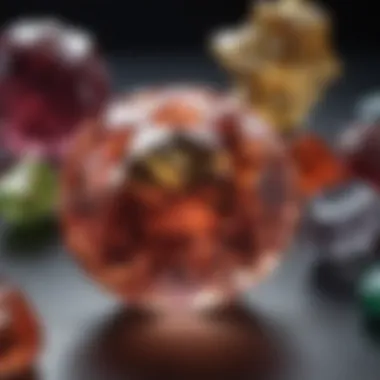
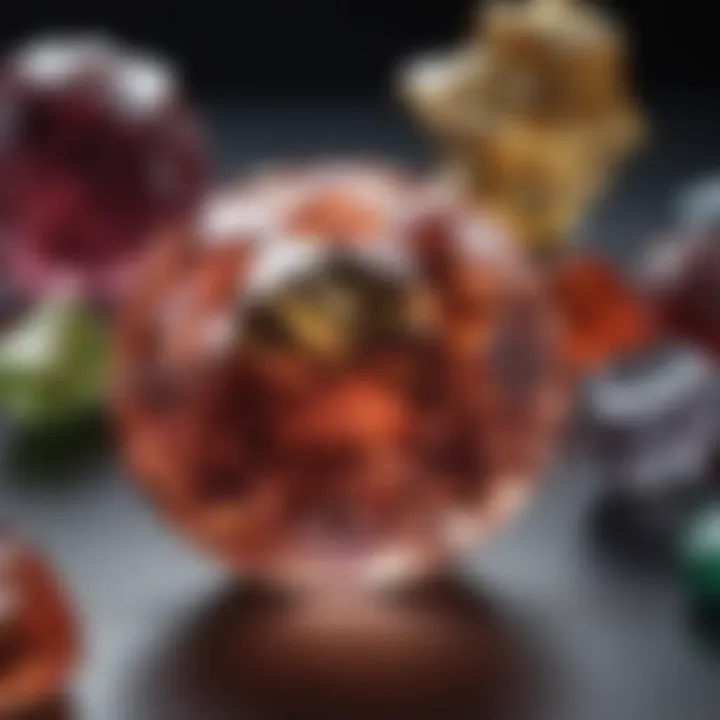
Assessing Personal Needs
Assessing personal needs in the context of karat is an exercise in self-reflection as well as market research. Before deciding on a karat, consumers should ask themselves a few key questions: What kind of usage will the jewelry see? Is it for everyday wear or special occasions? For instance, if it's a daily wear piece, opting for a lower karat gold, like 14 karat, makes more sense due to its durability compared to 24 karat, which is softer and more prone to scratches.
This personalized assessment is a beneficial choice that helps consumers avoid making impulsive decisions. Knowing your lifestyle allows you to select pieces that will last without needing excessive care. A unique feature of this consideration is that it not only focuses on the beauty of a piece but also its functionality. Thus, it balances aesthetics and practicality, ensuring satisfaction in both respects.
Budget Considerations
Budget considerations come into play as a fundamental aspect of purchase decisions. In the world of gemstones and jewelry, prices can vary significantly based on karat. Opting for higher karat gold tends to be more expensive, hence affecting the overall budget of a buyer. A prospective jeweler should include not just the cost of the item but also any future expenses, like maintenance or repairs.
For those on a tighter budget, selecting 14 or 18 karat solutions offers a way to enjoy quality gold without breaking the bank. The price point of such options makes them exceedingly popular among consumers looking to balance quality and affordability. However, a potential downside to this approach is the risk of sacrificing purity and overall lustre, but this is often a fair trade-off for many buyers.
Common Pitfalls to Avoid
When venturing into the world of karat and gemstones, there are several common pitfalls worth avoiding. One significant snag might be overlooking the fine print on karat specifics; consumers may mistakenly conflate karat with carat when purchasing gems, which can lead to misunderstandings regarding value and quality.
Additionally, the temptation to save money can lead consumers toward lower-quality pieces that might appear attractive at first glance but are composed of lesser materials. Always checking a jeweler’s certification and doing a bit of homework on the gemstone’s quality can go a long way in ensuring you make a well-informed choice.
In essence, the consumer perspective on karat revolves around knowledge and awareness. By understanding how personal needs and budget considerations intersect with the nuances of karat, one can navigate the jewelry market with confidence.
Future Trends in Karat and Gemstone Industry
The gemstone and karat industry is at a crossroads where tradition meets innovation. Understanding future trends in this sector is not just about keeping pace; it’s about anticipating changes that can affect consumers, collectors, and jewelers alike. Factors like technological advancements and shifts in consumer preferences are reshaping how karat is viewed and valued. By grasping these changes, stakeholders can better navigate the market and maintain a competitive edge.
Technological Advances in Karat Measurement
As technology continues to advance, the methods used to measure karat purity are becoming more precise and accessible. Traditional methods often involved laborious testing processes, but now, with sophisticated tools like X-ray fluorescence (XRF), karat measurement is quicker and non-destructive. This technology allows jewelers and appraisers to accurately assess gold purity without causing any damage to the item.
Benefits of these advancements include:
- Increased accuracy: Erroneous estimations that could mislead buyers are less likely, ensuring trust in the market.
- Accessibility: Small jewelers can employ these tools, leveling the playing field, as high-precision tools were once relegated to large firms.
- Transparency: With accurate measurement, consumers can make informed purchases, enhancing their overall experience.
"The future of karat measurement lies in precision and accessibility, ensuring that every gem meets the highest standards."
Shifts in Consumer Preferences
In recent years, consumers have started to show preference for more sustainable and ethically sourced gemstones and precious metals. This trend has led to a growing demand for transparent sourcing practices and eco-friendly production methods. The notion of what constitutes value is evolving, shifting attention away from mere karat purity towards broader ethical considerations.
Some key points to consider include:
- Sustainability: Buyers are looking for products that meet eco-friendly standards. This could mean supporting companies that engage in responsible mining practices.
- Personalization: Consumers are gravitating towards custom-designed pieces that reflect their individuality rather than mass-produced items. This trend highlights a strong desire not just for quality but for relevance.
- Education: As people become more knowledgeable about what karat means, they are looking for sellers who can offer insights and transparency, not just products.
Ending
In wrapping up the detailed exploration of karat, it is essential to grasp the pivotal role this term plays in both the jewelry and gemstones markets. The understanding of karat transcends mere numbers; it's about appreciating the materials that are crafted into beautiful items that people cherish. Knowing the significance of karat not only assists consumers in making educated purchases but also empowers them to connect deeper with their choices.
Recapitulation of Key Points
- Definition and Significance: At its core, karat defines the purity of gold and differentiates between various alloys. A solid understanding helps consumers navigate their options responsibly.
- Scientific Underpinnings: This measurement is backed by precise scientific parameters, making it necessary to know how karat is counted and categorized.
- Market Implications: The realities of market demand are directly linked to karat purity, influencing pricing and availability of gemstones and jewelry.
- Consumer Perspective: Being aware of factors such as personal needs and budget limitations can guide buyers towards choices that align with their desires without compromising quality.
- Future Trends: As technology progresses, the retail landscape around karat values may shift, influencing consumer preferences and practices.
Those delving into anything karat-related—whether they’re seasoned collectors or novice buyers—will find that understanding this term is a gateway to informed decisions and enriched appreciation for gems and precious metals.
Final Thoughts on the Importance of Understanding Karat
Understanding karat is not merely an academic exercise; it's a crucial part of engaging with the jewelry trade. For enthusiasts looking to invest, knowledge of karat can often be the difference between acquiring a true gem or a potentially misleading imitation.
Benefits of Knowing Karat Include:
- Investment Security: Knowledge of karat protects buyers from sinking funds into products of lesser value.
- Informed Choices: This forces sellers to provide accurate details, ensuring transparency is upheld.
- Enhanced Experience: Collectors who appreciate the intricacies of karat will find greater joy in their purchases.
"Understanding karat is like learning the language of gemstones; it opens doors to deeper connections and better investments."







